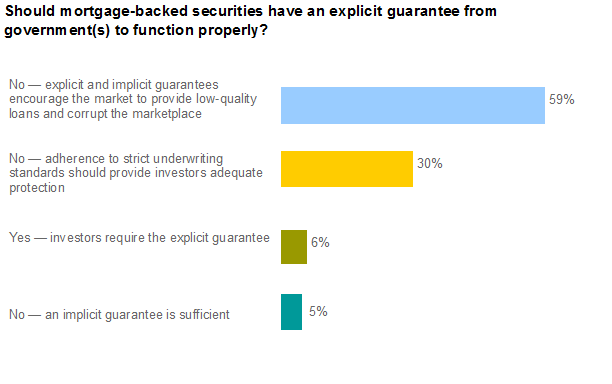MortgageBacked Securities_2
Post on: 29 Август, 2015 No Comment

Issue: Mortgage-backed securities (MBS) represent an indirect ownership interest in mortgage loans made by financial institutions. The value of MBS is secured by the value of the underlying bundle of mortgages that are pooled by issuers for sale to investors. MBS are issued or guaranteed by the U.S. government or a government-sponsored enterprise (GSE), or by private institutions.
Residential (RMBS)
RMBS are pools of residential mortgage loans that could include some or all different types of fixed and/or floating rate loans, such as prime, subprime, Alt-A and Option ARMs (adjustable rate mortgages). Institutional investors, including insurance companies, have historically been important institutional investors in RMBS, due in part to the long-term cash flows they provide, which are useful for offsetting long-term liabilities.
Insurers have been active in both the conforming mortgage finance segment, which has been heavily dependent upon two government-sponsored enterprisesthe Federal National Mortgage Association (Fannie Mae) and the Federal Home Loan Mortgage Corporation (Freddie Mac), which are currently under conservatorship by an agency of the federal governmentas well as on the more recently developed, and still distressed, non-agency segment.
Non-agency RMBS are issued by private institutions (not by governmental or quasi-governmental agencies) such as commercial banks, savings and loan institutions, and mortgage bankers. Their underlying collateral generally consists of mortgages which do not conform to the requirements (size, documentation, loan-to-value ratios, etc.) for inclusion in mortgage-backed securities issued by agencies such as Ginnie Mae, Fannie Mae or Freddie Mac.
Although insurers have shown over the years a preference for agency RMBS, they have also maintained a significant exposure to private-label mortgage securities (although the share of private-label RMBS has been declining in the years following the crisis.) As of year-end 2013, insurers held a total of $470 billion in RMBS, with Fannie Mae, Freddie Mac, and Ginnie Mae mortgage-related securities accounting for about 77 percent. Life insurance companies held the lions share of the industry total RMBS investments with about $88 billion in private-label RMBS and $234 billion in agency RMBS.
Until the recent financial crisis, the vast majority of RMBS held by the U.S. insurance industry were considered high-quality investments (rated investment grade or higher by one or more of the NRSROs.) The bonds were also attractive because they could be tailored through the investment structuring process to satisfying specific investor needs for duration and interest rate sensitivity, as well as other important investment attributes. Insurers in the past had typically needed to be more concerned about the cash flow volatility of non-agency RMBS that results from changing mortgage prepayment rates, than about credit quality issues.
Commercial (CMBS)
CMBS are securities which are backed by underlying collateral consisting of commercial mortgage loans on retail properties, office properties, industrial properties, multi-family housing and hotels. The properties are income producing and operate for economic profit. Commercial real estate loans used as collateral in these types of transactions are often ten-year, fixed-rate loans. The loans are often no more than 80% of the value of the property and the borrowers are required to maintain minimum cash balances to cover interest payments. Unlike residential mortgage loans, commercial mortgage loans often have strong protections (lock out periods) against prepayments for up to ten years.
CMBS are structured similarly to residential mortgage-backed securities with the principal and interest payments by the borrower from underlying loans being passed through to the holders of each tranche of the CMBS. Each tranche will have some layer of protection against failure of payment of principal and interest. This is often achieved through absorption of loan losses from the pool of mortgage loans initially by the lowest tranche of the CMBS pool and eventually working up toward the highest tranche.
Insurance companies continue to be major investors in CMBS, holding a total of approximately $154 billion as of 2013 year-end. Life insurers CMBS holdings accounted for about 79 percent of the total industry CMBS exposure.
RMBS/CMBS Valuation
The financial crisis and the collapse of the housing market greatly impacted the mortgage-backed market, as delinquency and loss performance of RMBS and CMBS rapidly deteriorated to a degree that far exceeded the level of default expectations of credit rating agencies. By the time rating agencies reacted to the apparent inadequacies of their modeling processes to adjust to the new market realities, an unprecedented massive ratings correction was necessary. The loss of market confidence on NRSRO credit ratings and the aggressive downgrading actions that followed, directly impacted insurers RMBS investment portfolios and the assessment of their risk-based capital (RBC) charges which are tied to NAIC designations mapped to NRSRO credit ratings.
Continued reliance on NRSRO ratings for year-end 2009 designations would have resulted in a nearly six-fold increase in life insurers RBC for mortgage-backed securitizations. The huge impact that the NRSRO ratings-based regulatory process for determining RBC had on insurance companies, along with the recognition of the data and methodological shortcomings that rendered NRSRO credit ratings inaccurate, necessitated the development for an alternative methodology. In response, in 2009 the NAIC initiated its Structured Securities Project to develop the new methodology that would allow for a more precise assessment of the value of RMBS held by insurers. This year (2014 year-end) is the sixth year for modeling RMBS and the fifth year for modeling CMBS.














